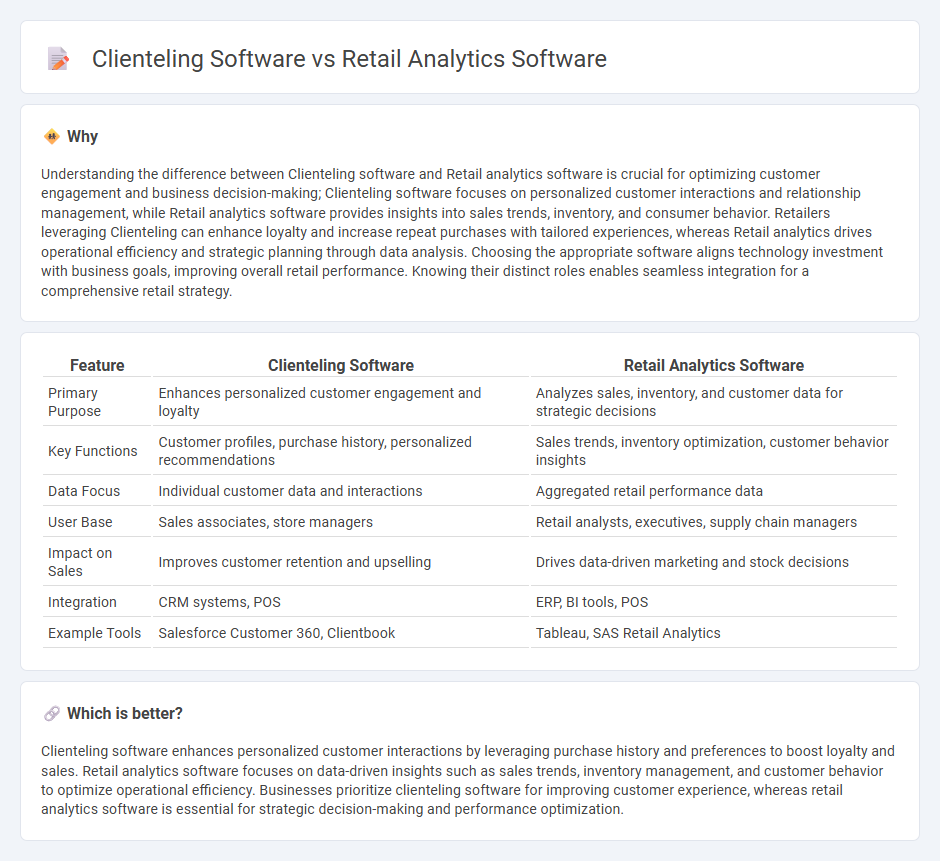
Clienteling software enhances personalized customer interactions by leveraging detailed CRM data, enabling sales associates to deliver tailored recommendations and build stronger customer relationships. Retail analytics software focuses on aggregating and analyzing large volumes of sales, inventory, and consumer behavior data to optimize store operations and strategic decision-making. Explore how integrating both solutions can revolutionize your retail strategy and drive sustained growth.
Why it is important
Understanding the difference between Clienteling software and Retail analytics software is crucial for optimizing customer engagement and business decision-making; Clienteling software focuses on personalized customer interactions and relationship management, while Retail analytics software provides insights into sales trends, inventory, and consumer behavior. Retailers leveraging Clienteling can enhance loyalty and increase repeat purchases with tailored experiences, whereas Retail analytics drives operational efficiency and strategic planning through data analysis. Choosing the appropriate software aligns technology investment with business goals, improving overall retail performance. Knowing their distinct roles enables seamless integration for a comprehensive retail strategy.
Comparison Table
| Feature | Clienteling Software | Retail Analytics Software |
|---|---|---|
| Primary Purpose | Enhances personalized customer engagement and loyalty | Analyzes sales, inventory, and customer data for strategic decisions |
| Key Functions | Customer profiles, purchase history, personalized recommendations | Sales trends, inventory optimization, customer behavior insights |
| Data Focus | Individual customer data and interactions | Aggregated retail performance data |
| User Base | Sales associates, store managers | Retail analysts, executives, supply chain managers |
| Impact on Sales | Improves customer retention and upselling | Drives data-driven marketing and stock decisions |
| Integration | CRM systems, POS | ERP, BI tools, POS |
| Example Tools | Salesforce Customer 360, Clientbook | Tableau, SAS Retail Analytics |
Which is better?
Clienteling software enhances personalized customer interactions by leveraging purchase history and preferences to boost loyalty and sales. Retail analytics software focuses on data-driven insights such as sales trends, inventory management, and customer behavior to optimize operational efficiency. Businesses prioritize clienteling software for improving customer experience, whereas retail analytics software is essential for strategic decision-making and performance optimization.
Connection
Clienteling software enhances personalized customer interactions by leveraging data collected through Retail analytics software, which tracks purchasing behavior, preferences, and trends. Retail analytics gathers detailed insights from sales, inventory, and customer engagement, enabling clienteling tools to tailor marketing campaigns and product recommendations effectively. This synergy boosts customer loyalty and increases sales by delivering targeted, data-driven shopping experiences.
Key Terms
Data Visualization (Retail analytics software)
Retail analytics software specializes in data visualization by transforming complex sales, inventory, and customer behavior data into intuitive charts, graphs, and dashboards that enable retailers to identify trends and make data-driven decisions quickly. Advanced features often include real-time updates, customizable reports, and predictive analytics models that provide actionable insights to optimize store performance and marketing strategies. Explore more on how retail analytics software leverages data visualization to boost operational efficiency and customer satisfaction.
Customer Profiles (Clienteling software)
Retail analytics software provides aggregated customer data through sales trends, inventory levels, and purchasing behaviors to enhance operational decisions. Clienteling software offers detailed customer profiles, capturing individual preferences, purchase history, and personalized communication to foster direct relationships and improve client retention. Explore how advanced clienteling solutions can transform customer engagement and drive loyalty.
Sales Performance (Retail analytics software)
Retail analytics software enhances sales performance by providing data-driven insights into customer behavior, inventory management, and sales trends, enabling retailers to optimize product assortment and pricing strategies. This software leverages advanced analytics and AI to forecast demand and identify high-performing sales channels, ultimately boosting revenue and operational efficiency. Explore how retail analytics software can transform your business sales performance through comprehensive data analysis and actionable insights.
Source and External Links
Retail Analytics Software: Top Picks & Use Cases (2025) - Shopify Analytics offers real-time, integrated retail insights including sales trends, inventory, marketing effectiveness, and customer behavior across all sales channels, included with every Shopify plan.
Retail Analytic Software, Tools & Data Warehousing by Aptos - Aptos Analytics leverages AI and machine learning to aggregate and illuminate retail data across the enterprise, optimizing inventory management and enabling strategic decision-making with decades of retail expertise embedded.
Rebiz - Retail Sales Analytics and Operations Monitoring - ReBiz provides multi-unit retailers with daily operational insights down to individual employee performance, helping improve sales, store operations, and profitability with tailored coaching tools.
 dowidth.com
dowidth.com